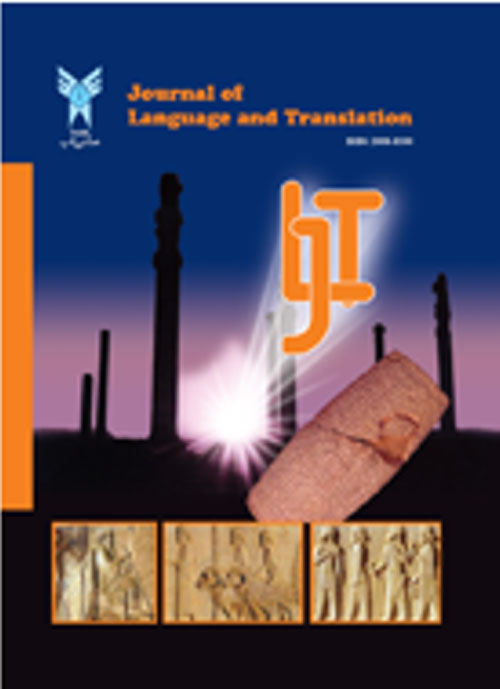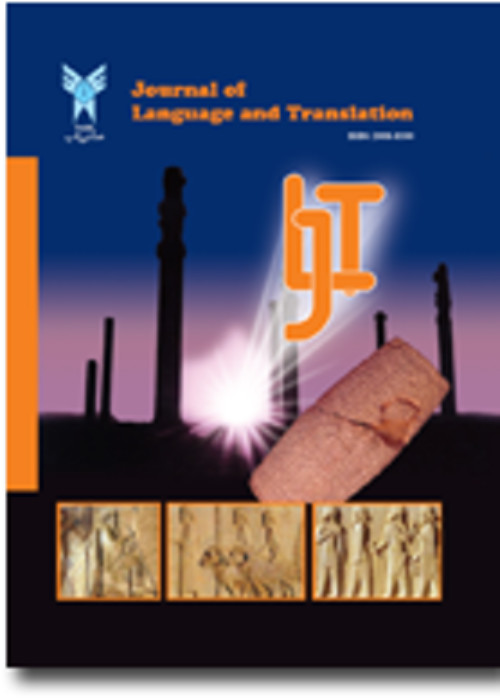فهرست مطالب

Journal of Language and Translation
Volume:5 Issue: 2, Autumn 2015
- تاریخ انتشار: 1394/08/25
- تعداد عناوین: 9
-
Pages 1-11The purpose of this study was to explore whether film-based Dynamic Assessment (DA) could affect English writing of Iranian deaf children. Ten students studying in a school for the deaf took part in the study. The participants writing ability was measured prior to the treatment and the errors which were identified. A series of meditating activities were designed and implemented during a three-month treatment. After the treatment, a writing posttest was administered. The results of the paired samples t-test revealed that using film-based DA had a significant impact on the English writing of the participants. The results of the structured interviews showed that almost all students had positive attitudes towards the use of films during the DA procedure.Keywords: Deaf children, Dynamic Assessment, English writing, Films
-
Pages 13-21This study investigated the effect of using visual aids, semantic elaboration, and visual aids plus semantic elaboration on the Iranian EFL learner's vocabulary learning. To conduct the study, the researchers assigned 49 elementary learners to three homogeneous groups according to their proficiency level. Then, a pre-test of Paribakht and Wesche's Vocabulary Knowledge Scale was given to each group. As the treatment, the first experimental group consisting of 17 learners received visual aids instruction. The second experimental group had 16 learners who received semantic elaboration method. The last experimental group including 16 learners received visual aids plus semantic elaboration instruction. After the treatment, a similar post-test was used again. Then, an ANOVA analysis was run on the data. The results of ANOVA analysis indicated a significant difference in the performance of the learners of three groups in their post-tests. For determining the place of the differences, post hoc test analysis was used. The results demonstrated that the visual aids plus semantic elaboration group outperformed the other two groups.Keywords: Vocabulary, Visual aids, Semantic elaboration
-
Pages 23-41Teachers verbal behavior is a key contributor to provision of appropriate indirect intervention in language learning contexts; however, it is surprising that professionals in ELT, to date, have not proposed a structured oral/verbal framework to deliver intervention and assistance in language learning contexts. To help redress this gap, Herons Six-Category Intervention Analysis was adapted to put forward a new method to regulate the verbal behavior and actual sentences used by the instructors to intervene in the language learning contexts. 175 Iranian EFL learners taking general English courses with teaching reading comprehension skills and strategies in focus participated in four experimental groups and one control group. Five 35-member groups included control, written mediation only, authoritative intervention, facilitative intervention, and synergetic authoritative-facilitative interventions. Preliminary English Test was employed to evaluate the performance of language learners on their reading comprehension. Results indicated that firstly application of Six-Category Intervention Analysis while providing dynamic assessment induced significant changes in the performance of the groups. Secondly, facilitative intervention, and synergetic authoritative-facilitative interventions groups, generally outperformed other groups with the former ranking first in three, and the latter in two of the six reading comprehension tests.Keywords: Authoritative, Dynamic Assessment (DA), Facilitative, Intervention, Strategies, Synergetic
-
Pages 43-59The motive behind this study was to evaluate the Iranian State University EFL Entrance Examination Test (UEEET) based on Bachman and Palmers (1996) Usefulness Six-faceted Model accommodating Relia- bility, Validity, Impact, Interactiveness, Authenticity, and Practicality. To do so, thirty professors and one-hundred EFL freshmen were selected randomly from five universities. A questionnaire consisting of thirty likert-scale items and six open-ended questions were developed based on Bachman and Palmers (1996) framework. They were administered to both groups of the participants along with the 2013 sample of the Iranian State UEEET. In addition to the questionnaire, a structured interview consisting of ten questions was also run for the purpose of triangulation of the data. Based on the findings, both groups evaluated the UEEET mainly less reliable, less practical and entailing negative impacts, while they held positive views towards its validity, authenticity, and interactiveness. Certain contradictions in the results leave the space open for further investigations, of course. Overall, the UEEET is evaluated as a test enjoy- ing an acceptable degree of the Usefulness criteria.Keywords: Iranian State University EFL Entrance Examination, Test Usefulness, Test Evaluation
-
Pages 61-75TOEFL iBT has turned recently heads to the impacts language tests can have on language learning. Since error analysis-based instruction has gained a new life with the advent of the computer analysis of the learners language, the researchers of this study embarked on examining a sample of integrated and independent writing tasks of 45 Iranian TOEFL iBT candidates in order to identify and classify their errors. Examining 90 writing tasks in toto, the researchers categorized the errors into three major categories: grammar, mechanics, and content errors. Although, the errors of integrated and independent tasks at the levels of grammar and mechanics, with slight differences, had much to share, the content errors exhibited considerable differences. The content errors of the integrated task included plagiarism, for instance while the independent category was limited to organization of ideas and task fulfillment. Given the relative youth of TOEFL iBT for language teachers and learners, the results of this study can have promising potential for enhancing Iranian TOEFL iBT teachers understanding of the problems of their prospective candidates. The findings can also be used to improve TOEFL iBT preparatory materials as adopting a troubleshooting approach seems to be more viable in short-term tailor-made courses.Keywords: Error Analysis (EA), TOEFL iBT writing, Independent writing tasks, Integrated writing
-
Pages 77-86This study was conducted to examine the impact of formative and summative assessment in the professional development of Iranian EFL Instructors at universities. Moreover, an attempt was made to figure out whether the formative assessment is more effective than the summative assessment. Since the present work is qualitative/quantitative research in nature, it was conducted within the ethnography of Islamic Azad University South Tehran Branch. To do so, two M.A classes were chosen and the data were collected via observations, field notes, interviews, stimulated recalls, questionnaires and through audio- video recordings. The findings of this study suggest that the formative and summative assessment enhance the practices of teaching by university instructors and that the formative assessment is more effective and beneficial.Keywords: Formative assessment, Summative assessment, Professional Development, evaluation, SETs
-
Pages 87-100Translation is an indispensable tool for communication between the diverse linguistic groups. It opens new horizons for the people living in a country so that it makes changes and improvements in their society, especially in the literature. Through the translation process, some literary principles and elements are introduced into the home literature which did not exist before. These features emerge not only as new models of reality to function as a substitute for old and established literary conventions that are no longer effective, but as a whole range of other features as well, such as compositional patterns and techniques or literary genres and forms (Even-Zohar, 1990). During the late nineteenth and early twentieth century, translation from European languages caused that the Persian literature began experiencing new trends in poetry and prose, leading to the rise of modern Persian literature. This study aims to scrutinize the signifi- cant role of the translated western literature in the rise of the modern Persian literature, for this purpose, new literary genres introduced into the Persian literary polysystem through the translation of the western works have been studied. It employs Even-Zohar's polysystem theory to investigate the conditions which gave rise to the literary interference in Iran and to illuminate the main reasons which resulted in the canonization of the translated works in the Persian literary polysystem. It shows that the translations transferred new models and themes with themselves, which were decisive in shaping modern Persian literature.Keywords: Canonization, Literary interference, Literary polysystem, Modern Persian literature, Translation
-
Pages 101-110The present study is an attempt to analyze the characters in the novel Blindness and its cinematic adapta- tion from intersemiotic viewpoint. To this end, the researchers provided a synthesized model, which is a combination of Bernando (2012) and Forster's (1927) classification of characters in order to analyze the two main characters from intersemiotic viewpoint. Considering the difference between a uni-sign system's tools, which is the novel and a multi-sign system's tools, which is the movie, the results of this research showed that the filmmaker could reflect the representative signs of the novel characters in the movie characters properly by means of cinematic techniques; therefore, he was able to be loyal to create the characters described by the author.Keywords: adaptation, character, intersemiotic, semiotic
-
Pages 111-117As onomatopoeic words or expressions are attractive, the users of languages in the fields of religion, literature, music, education, linguistics, trade, and so forth wish to utilize them in their utterances. They are more effective and imaginative than the simple words. Onomatopoeic words or expressions attach us to the real nature and to our inner senses. This study aims at familiarity with onomatopoeia, its trans- lation, and usage by bringing pure studies on onomatopoeia into practice, and drawing a map of verbal onomatopoeic utterances in the nature more objectively. It also wishes to pave the way in future for providing onomatopoeic dictionaries and other reference books. To do so, it has primarily followed a library research by which the researcher gathered information through legitimate references and heuris- tically and qualitatively analyzed it. The pertinent instrumentation comprised in content analysis of Tintins story books in English language, and first and second translations in Persian language each in four volumes via Hinton et al.s model of sound symbolism, semi-structured interview, and inter-rated coding with 10 readers and a publisher. Data analysis shows that Persian translations of onomatopoeias are phonetically and culturally adaptable to the original texts.Keywords: Onomatopoeia, Sound symbolism, Interjection, culture, Children's literature


